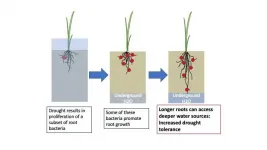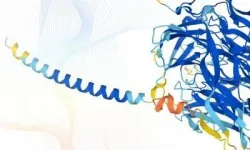(Press-News.org) Gene therapy in mouse models showed promise in preventing vision loss or blindness from serious retinal injury including optic nerve damage, and from retinal disease including diabetic retinopathy and glaucoma, Mount Sinai researchers report. Their study, published in the July 22 online publication of Cell, could transform treatment for those at risk of major vision loss from retinal degenerative diseases, which currently have no cure.
The researchers focused on retinal ganglion cells, which process visual information by sending images to the brain. These cells can degenerate as a result of retinal injury and retinal disease. The team of researchers demonstrated how reactivation of a key enzyme known as CaMKII and its downstream signaling in retinal ganglion cells through a gene therapy approach provided robust protection against further vision loss or impairment in multiple disease and injury models.
"Neuroprotective strategies to save vulnerable retinal ganglion cells are desperately needed for vision preservation," says senior author Bo Chen, PhD, Associate Professor of Ophthalmology and Neuroscience, and Director of the Ocular Stem Cell Program at the Icahn School of Medicine at Mount Sinai. "We uncovered evidence for the first time that CaMKII is a key regulator of the survival of retinal ganglion cells in both normal and diseased retinas, and could be a desirable therapeutic target for vision preservation in conditions that damage the axons and somas of retinal ganglion cells."
Glaucoma is the leading cause of irreversible visual impairment worldwide, affecting 76 million people, some of whom will progress to blindness despite aggressive treatment to reduce the pressure in their eyes. The major barrier to restoring vision loss from glaucoma and other retinal diseases and injuries is that the long nerve fibers known as axons, which allow retinal ganglion cells to process visual information by converting light that enters the eye into a signal transmitted to the brain, do not regenerate. For that reason, neuroprotective strategies to preserve the RGC's axons and somas (the main body of the nerve cell from which axons branch off along the optic nerve to the brain) and thereby prevent further vision loss are urgently needed.
Mount Sinai researchers investigated whether CaMKII could play such a therapeutic role. They tested the enzyme across a wide range of injury and disease animal models, including optic nerve damage, excitotoxicity (where nerve cells are destroyed by the overactivation of glutamate receptors that result in damage to the cell structure), and two glaucoma models that mimicked the pathophysiology of human disease with both high and normal intraocular pressure. The team learned that CaMKII regulated the survival of retinal ganglion cells across many of these pathologies, and that in the small-animal excitotoxicity model, insults to the retinal ganglion cell's somas or optic nerve injury to its axons led to inactivation of CaMKII and its downstream signaling target CREB (or cAMP response element binding protein). "Intriguingly, we found that reactivation of CaMKII and CREB provided robust protection for retinal ganglion cells," notes Dr. Chen, who is also the McGraw Family Vision Researcher at Icahn Mount Sinai, "and that CaMKII-mediated protection slowed down the disease progression in both glaucoma models."
That reactivation was made possible by a gene therapy approach deployed by the researchers to introduce a more active type of CaMKII into the original retinal ganglion cells to boost their activity. The modified version of CaMKII, with a mutated amino acid, was transferred to the targeted cells through an adeno-associated viral vector, a Food and Drug Administration-approved gene delivery system common to the growing field of gene therapy.
"Our research showed that CaMKII could indeed be a valuable therapeutic target to save retinal ganglion cells and preserve vision in treating potentially blinding diseases like glaucoma," says Dr. Chen, a winner of the Pew Scholars in the Biomedical Sciences award given to young investigators showing outstanding promise. "The fact that manipulation of CaMKII would involve a one-time transfer of a single-gene adds to its vast potential to treat serious retinal conditions in humans. The next step is testing this in larger animal models, which may pave the way for starting clinical trials."
Mount Sinai has filed patent applications for this technology through Mount Sinai Innovation Partners (MSIP), the commercialization arm of the health system. MSIP is in active discussions with multiple companies to help advance this treatment to the clinic.
INFORMATION:
This study is supported by the National Eye Institute (NEI), which is part of the National Institutes of Health, along with the Research to Prevent Blindness and The Harold W. McGraw, Jr. Family Foundation.
About the Mount Sinai Health System
The Mount Sinai Health System is New York City's largest academic medical system, encompassing eight hospitals, a leading medical school, and a vast network of ambulatory practices throughout the greater New York region. Mount Sinai is a national and international source of unrivaled education, translational research and discovery, and collaborative clinical leadership ensuring that we deliver the highest quality care--from prevention to treatment of the most serious and complex human diseases. The Health System includes more than 7,200 physicians and features a robust and continually expanding network of multispecialty services, including more than 400 ambulatory practice locations throughout the five boroughs of New York City, Westchester, and Long Island. The Mount Sinai Hospital is ranked No. 14 on U.S. News & World Report's "Honor Roll" of the Top 20 Best Hospitals in the country and the Icahn School of Medicine as one of the Top 20 Best Medical Schools in country. Mount Sinai Health System hospitals are consistently ranked regionally by specialty and our physicians in the top 1% of all physicians nationally by U.S. News & World Report.
For more information, visit https://www.mountsinai.org or find Mount Sinai on Facebook, Twitter and YouTube.
Geneticists from Trinity College Dublin have discovered how a specific genetic mutation called H3K27M causes a devastating, incurable childhood cancer, known as diffuse midline glioma (DMG), and - in lab studies working with model cell types - successfully reverse its effects to slow cancer cell growth with a targeted drug.
Their landmark work - just published in leading international journal, Nature Genetics and supported by Worldwide Cancer Research and The Brain Tumour Charity - translates crucial new understanding of the genetics of DMG progression into ...
A form of gene therapy protects optic nerve cells and preserves vision in mouse models of glaucoma, according to research supported by NIH's National Eye Institute. The findings suggest a way forward for developing neuroprotective therapies for glaucoma, a leading cause of visual impairment and blindness. The report was published in Cell.
Glaucoma results from irreversible neurodegeneration of the optic nerve, the bundle of axons from retinal ganglion cells that transmits signals from the eye to the brain to produce vision. Available therapies slow vision loss by lowering elevated eye pressure, however some glaucoma progresses to blindness despite normal eye pressure. Neuroprotective therapies would be a leap forward, meeting ...
Advances in microscopy have enabled researchers to picture loops of DNA strands for the first time. The images reveal how the human genome organises itself in three-dimensional space at much higher resolution than previously possible.
The findings, published in a new study in the journal Molecular Cell, also reveal that the process of DNA being copied into RNA - transcription - indirectly shapes the architecture of the genome. An international team led by Pia Cosma at the Centre for Genomic Regulation (CRG) in Barcelona and Melike Lakadamyali at the Perelman ...
Manipulating RNA can allow plants to yield dramatically more crops, as well as increasing drought tolerance, announced a group of scientists from the University of Chicago, Peking University and Guizhou University.
In initial tests, adding a gene encoding for a protein called FTO to both rice and potato plants increased their yield by 50% in field tests. The plants grew significantly larger, produced longer root systems and were better able to tolerate drought stress. Analysis also showed that the plants had increased their rate of photosynthesis.
"The change really is dramatic," said University of Chicago Prof. Chuan He, who together with Prof. Guifang Jia at Peking University, led ...
A new study showed that a wearable computer vision device can reduce collisions for both people who are blind or those who are visually impaired and using a long cane and/or guide dog by 37 percent, compared to using other mobility aids alone.
People who have visual impairments are at a significantly higher risk for collisions and falls. Commonly used mobility aids like long canes and guide dogs can offer benefits, but come with limitations in effectiveness and costs, respectively. While some electronic devices are marketed direct-to-consumer claiming to warn wearers of surrounding objects, there has been little evidence of their effectiveness in actual daily mobility settings. This is one of the first randomized-controlled trials to look at the potential benefit of the ...
What The Study Did: This study included 647 patients with untreated nonmetastatic prostate cancer (269 patients during the pandemic and 378 from before the pandemic). During the initial COVID-19 lockdown, only 1% of Black men underwent prostatectomy, while 26% of white patients did. Prior to the pandemic, there was no difference in the rate of prostatectomy between the two races (18% of Black men and 19% of white men). The lessons from this study suggest systemic inequities within health care and are likely applicable across medical specialties. Public health efforts are needed to fully recognize the unintended consequence of diversion of cancer resources to the COVID-19 pandemic to develop balanced mitigation strategies as viral rates continue to fluctuate.
Authors: ...
Drought can have a lasting impact on the community of microbes that live in and around roots of rice plants, a team led by UC Davis researchers has found. Root-associated microbes help plants take up nutrients from the soil, so the finding could help in understanding how rice responds to dry spells and how it can be made more resilient to drought. The work is published July 22 in Nature Plants.
The root microbiome of irrigated rice plants goes through a sequence of changes as the plants grow and stabilizes when they flower. The sequence of changes in the root ...
Restoration of degraded drylands is urgently needed to mitigate climate change, reverse desertification and secure livelihoods for the two billion people who live there, experts warn in a major new paper in Nature Ecology & Evolution.
Scientists leading the Global Arid Zone Project examined restoration seeding outcomes at 174 sites on six continents, encompassing 594,065 observations of 671 plant species - with the lessons learned important to meeting ambitious future restoration targets.
Flinders University Dr Martin Breed, one of three Australian researchers who helped coordinate ...
LONDON, 22 July 2021 - DeepMind today announced its partnership with the European Molecular Biology Laboratory (EMBL), Europe's flagship laboratory for the life sciences, to make the most complete and accurate database yet of predicted protein structure models for the human proteome. This will cover all ~20,000 proteins expressed by the human genome, and the data will be freely and openly available to the scientific community. The database and artificial intelligence system provide structural biologists with powerful new tools for examining a protein's three-dimensional structure, and offer a treasure trove of data that could unlock future advances and herald a new era for AI-enabled biology.
AlphaFold's recognition in December 2020 by the ...
Newly-hatched pterosaurs may have been able to fly but their flying abilities may have been different from adult pterosaurs, according to a new study.
Pterosaurs were a group of flying reptiles that lived during the Triassic, Jurassic and Cretaceous Periods (228 to 66 million years ago). Due to the rarity of fossilised pterosaur eggs and embryos, and difficulties distinguishing between hatchlings and small adults, it has been unclear whether newly-hatched pterosaurs were able to fly.
Researchers from the Universities of Portsmouth and Bristol, along with palaeontologist Darren Naish, found that hatchling humerus bones were stronger than those of many adult pterosaurs, indicating ...





